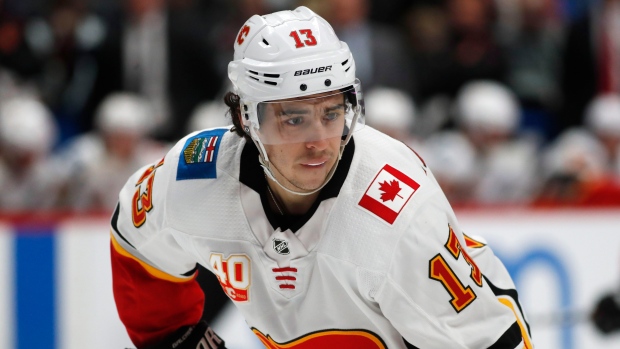Nov 26, 2020
Flames banking on bounce-back seasons from core players
The Calgary Flames opted not to overhaul the core parts of the roster, instead allotting resources elsewhere, which means they're betting on a bounce-back season from their top players. Travis Yost has more.
By Travis Yost

If you followed the Calgary Flames through this off-season, you know they were aggressive in addressing personnel on the defensive side of the ice. Their two most notable signings – goaltender Jacob Markstrom and defenceman Chris Tanev – both come from the division rival Vancouver Canucks.
Neither signing was a surprise. The Flames have been looking to address the goaltending position for some time now, and David Rittich’s .907 save percentage as the starter last season did little to change their mind. The reliable Tanev was a necessary blueline addition after the losses of T.J. Brodie (Toronto) and, in all likelihood, Travis Hamonic (unsigned).
The Flames opted not to overhaul the core parts of the roster, which is similarly interesting. It is particularly true in the forward group, where the likes of Johnny Gaudreau, Matthew Tkachuk, Sean Monahan, Mikael Backlund and Elias Lindholm will see the bulk of the top-six minutes. Behind them, the same left defenceman anchors their respective pairings: veteran Mark Giordano and youngster Noah Hanifin.
Quietly, the team is betting that this group can turn it around after a bizarre 2019-20 season. To paint it in broad strokes: every core player, sans Giordano, was outscored at even strength last season. When Calgary’s best units were paired together, the results weren’t any better.
Let’s focus on Calgary’s top line and top pairing for a moment. The Flames have used the Monahan/Gaudreau forward tandem for years, usually in front of the Giordano pairing. The other two positions tend to rotate through. Last year, the Flames tried Lindholm and Backlund on Monahan’s other wing, and Giordano played with Brodie and Rasmus Andersson.
First, let’s look at the Calgary top line over the past three seasons and their respective production at even strength:

You will notice a pretty considerable drop-off in performance last season – their goal rates and expected goal rates fell below 50 per cent, which is a major red flag for any organization. Even their historically awesome territorial advantages in shot differentials were hovering around break-even. Considering the fact that the Flames received strong goaltending (91.9 per cent stop rate) with this trio on the ice, and considering this same exact line saw much better numbers in 2018-19, last season’s goal differential numbers are even more alarming.
Knowing that the goaltending held up its share with the top line on the ice, and knowing these trios played hundreds of minutes together, our attention naturally turns to the defensive groups. Is it possible production were thwarted by personnel changes on the blueline?
It was certainly a contributor, though the extent of it is hard to pin down. For example: Gaudreau played the lowest percentage of minutes with the Giordano pairing in three seasons, getting an equitable amount of time with Hanifin’s second pairing. But if we isolate on skater performance and use expected goals – blind to both great and adverse goaltender impact on the defensive end – you’ll notice that the top line’s performance took a considerable step back last season, irrespective of who they were playing with:

It’s worth mentioning that if we look at the goal percentages for last season, it tells a bit of a different story – the Flames outscored their opponents 13 to seven with Gaudreau and Giordano on the ice as one example, and were outscored 15 to 13 by their opponents with Gaudreau and Hanifin on the ice together. But the Giordano/Gaudreau combination was heavily influenced by sterling goaltending in those stretches, with Rittich and Cam Talbot stopping nearly 96 per cent of shots.
So why is it so concerning? It’s the first time we have really seen expected goals and actual goals wildly deviate for these player pairs. Historically, the Calgary top line and the Giordano pairing have been sensational at holding the offensive zone and applying sustained pressure through shot volume dominance. Consider just the Gaudreau/Giordano combination for a moment:

Historically, we see those three key underlying measures in parallel, though the sample sizes of goal scoring tend to be more volatile than the other two. At any rate, the indication is that for the first time in years, Calgary’s best units were much less effective than in years past.
We see this manifest itself in other ways, too. Even a measure as straightforward as rate-scoring at even strength was concerning for the Flames top line. Gaudreau’s 1.7 points per 60 minutes was a four-year low. Monahan’s 1.5 points per 60 minutes was a four-year low. Lindholm’s 1.8 points per 60 minutes was down from his first season in Calgary, too.
The bet by Calgary, I think, is the slowed production from Calgary’s best players was an outlier, and that a strong rebound season is on the horizon. The optimist would point out that these players have a track record of producing together over multiple seasons, and that a healthier Giordano – the 2018-19 Norris Trophy winner was nagged by a hamstring injury in the second half of the season – could be a major spark behind that. The pessimist would note that Giordano is now 37 years old, and that we might be seeing the first indications of an elite defender slowing down.
At any rate, the upcoming season will be pivotal for Calgary’s core. The franchise is quite reliant on this sub-group of players delivering wins to the standings, as they have for half of a decade now. On their game, the Flames are as dangerous as any team in the Western Conference. But if next season looks like last season, the organization may be forced to consider more aggressive roster decisions.
Data via Natural Stat Trick, Evolving Hockey, NHL.com, Hockey Reference


